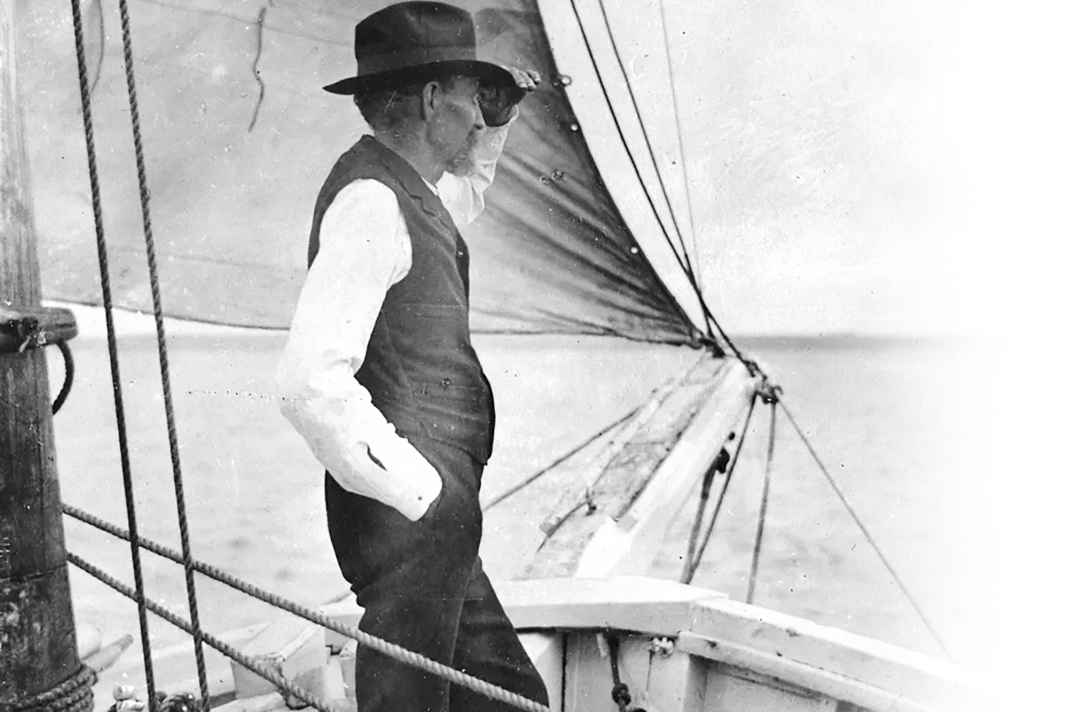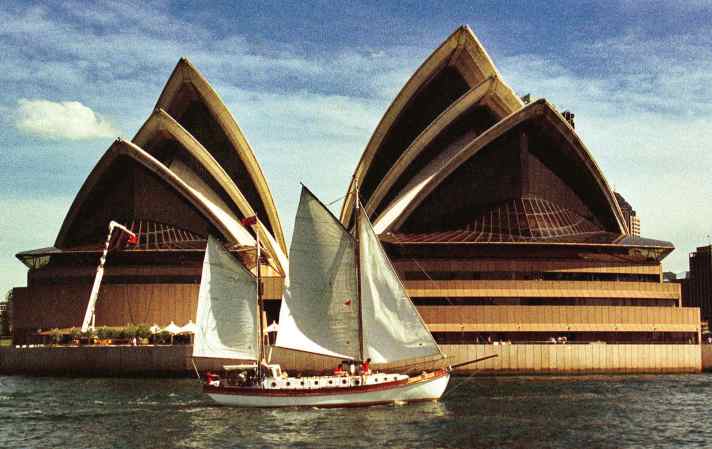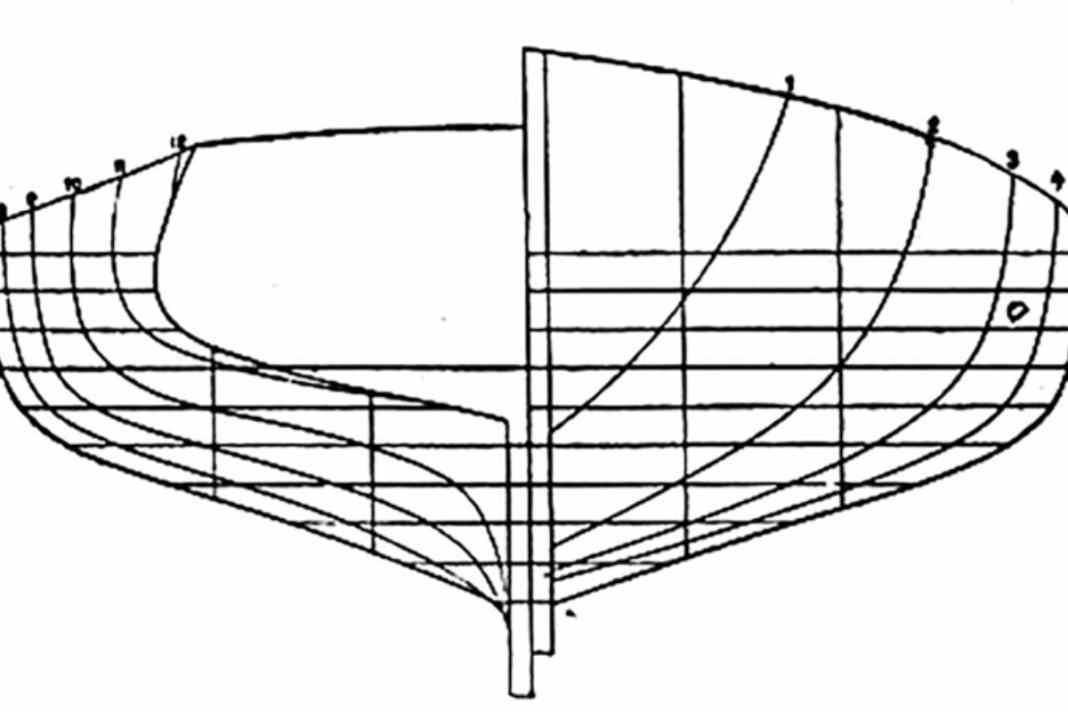





- A career in merchant shipping
- Slocum fails - both professionally and privately
- In 1892, Slocum's life took a turn for the worse.
- The greatest challenge of the circumnavigation will be the passage of the Strait of Magellan
- "Spray" is presented at the world exhibition
- Replicas of the "Spray": Mother of all single-handed sailing yachts
- Technical data of the "Spray"
Joshua Slocum was born in Nova Scotia, Canada, in 1844, the fifth of eleven siblings. At the age of eight, after only two years at school, the family moved to Brier Island because the income from their farm was not enough to live on. The island lies at the entrance to the Bay of Fundy. The inhabitants live off what the sea gives them. The houses are mostly made of wood from the ships that ran aground on the rocky coast. Slocum's father is a tyrant and regularly drags young Joshua to church services at the Baptist church. Otherwise, the boy toils in his father's workshop, where they make leather boots for the local fishermen.
Slocum hates the boot trade, but quickly develops a fascination for the ships he can observe through the dirty workshop windows. He secretly carves a model ship until his father finds it and destroys it in a fit of rage. Joshua craves a life of adventure as a sailor and makes several attempts to escape. At the age of 14, he signs on as a cook on a fishing schooner, but soon has to return home.
Also interesting:
In 1860, Slocum's beloved mother died after giving birth to her eleventh child, whereupon the 16-year-old Slocum left Brier Island for good and signed on to a timber freighter that took him to Dublin. Two years of apprenticeship on board a British merchant ship followed, during which Slocum progressed through the ranks at lightning speed to hold his second officer's licence in his hands at the age of 18.
At this time, maritime trade under sail is at its peak. The harbours of North America are bustling with magnificent tall ships unloading goods from all over the world and loading export goods again. Slocum has found his calling, not realising that this boom would be over 20 years later.
Slocum first came face to face with death on the Atlantic when he was hit by a gust of wind while sailing and fell out of the mast. He is lucky to survive the fall, but retains a scar over his left eye as an eternal memento. Over the course of the years, he would escape what he thought was certain death several more times, which is why he even gave his guardian angel a name: "Slocum's luck".
The protégé is the perfect example of a man who takes his happiness into his own hands and pursues his career with determination. "I was born in the breeze and studied the sea like few others, neglecting everything else," he later writes in his book.
A career in merchant shipping
Slocum is obsessed with the sea and feels deeply connected to it. In the 1860s and 1870s, he sailed the Atlantic, the Caribbean, the Pacific and the South China Sea. In 1869, he was given his first command of a coastal schooner, and shortly afterwards he commanded the barque "Washington", which he took on a long voyage.
A year later, he travelled to Australia, where he met his second great love at a ball: Virgina Albertina Walker. Although he was only ashore for three weeks, he managed the feat of falling in love, going out with her and ultimately asking her to marry him.
She not only says "I do", but is also willing to lead a life as a sailor's wife. One day after the wedding, they weigh anchor together. Their first son Victor and six other children are all born on board on the high seas or in distant harbours.
In 1881, Slocum was given command of the clipper "Northern Light". He is at the peak of his career: financially successful, highly respected, having sailed around the world five times. At the age of 40, he was also given the opportunity to buy into the fast clipper.
But the zenith of merchant shipping under sail had long since been reached. A dark cloud spreads over maritime trade: steam shipping. Modern ships were being launched everywhere to gradually replace the tall ships. For Joshua Slocum, however, they are "dirty, stinking steamships!".
A round-the-world voyage with the "Northern Light" will be Slocum's last great voyage with a merchant ship and seems to be cursed. First the captain has to contend with mutinous sailors, then they narrowly escape a volcanic eruption in the Sunda Strait. Finally, off the coast of South Africa, the rudder head breaks during a storm and most of the valuable cargo has to be thrown overboard to prevent the ship from capsizing.
The Slocums sell their shares in the "Northern Light" and acquire the smaller barque "Aquidneck" in exchange, with which they set off for South America to transport trade goods between North and South America. But while they were anchored off Buenos Aires in 1884, Virgina Walker died of heart failure. From the first day of their marriage, she had accompanied Joshua Slocum on all his sea voyages for 13 years. Now she is buried on land. His father then "sailed on like a ship with a broken rudder", as his eldest son Victor later described this time.
Slocum fails - both professionally and privately
Slocum returns to North America and marries a 24-year-old cousin from Nova Scotia. A marriage of convenience that does not go well. During a crossing to Brazil, he loses his entire cargo, including expensive pianos. As cholera is rampant, there is a long quarantine stop on Ilha Grande, an island off Rio de Janeiro, during which the entire crew deserts and makes off in the dinghy.
For the next two years, Slocum travelled between Brazil, Argentina and Uruguay to transport mate tea, cattle and alfalfa. In December 1887, the "Aquidneck" ran aground on a sandbank in the Brazilian Baja de Paranaguá and could not be rescued. Although no one was injured, the lack of insurance meant that the Slocums were financially shipwrecked.
In distress, the stranded captain decides to build a new ship so that he and his family can sail home again. He manages to salvage a few tools and timbers from the wreck, the rest is put together from tropical woods. His son Victor actively helps with the boat building, while "Madame" sews the sails. Over a six-month construction period, a 35-foot-long ship is created, whose unusual design is based on a Cape Ann Dory and a Japanese sampan with a junk rig.
The feat succeeds: After a total of 53 days at sea and 5,510 miles in its wake, the "Libertade" reaches Cape Romain in South Carolina. The Slocums finally reached Boston in 1889 via the unfinished Atlantic Intracoastal Waterway, a coastal waterway consisting of canals, rivers and bays. After the hardships of the shipwreck and the adventurous return journey, his second wife had had enough of sailing and went ashore for good. She takes the children with her.
Within a few years, Slocum had lost everything: His wife, home, fortune, family and job. The world around him is also changing rapidly. Electric trams replace horse-drawn carriages, railways and steamships replace sailing ships. Slocum tries to adapt and embarks on a seemingly bizarre mission: the transfer of an armoured ship from New York to Brazil. But the "Destroyer" is designed for harbour defence and cannot withstand the stresses and strains of the high seas. The rivet seams do not hold tight and the crew can only keep the ship afloat by constantly pumping.
In 1892, Slocum's life took a turn for the worse.
Back in the United States, the disillusioned Slocum happens to enjoy a reading by Herman Melville, who, fuelled by the spirit of the industrial revolution, ignites a new thirst for adventure. This falls on fertile ground with Slocum. If cargo ships are no longer needed, why not sail around the world alone in a smaller boat and then sell these adventures in book form?
The year is 1892, many tall ships have already been stripped of their masts and converted into coal barges, and their retired captains are beginning their early retirement in Sailors' Snug Harbour, a sailors' home in New York. Not so Joshua Slocum. His life takes a new turn this year. A whaling captain friend offers him a 100-year-old oyster fisherman, which he says is in need of an "overhaul".
In fact, the "Spray" is in a pitiful state and needs to be completely refurbished. She is moored ashore near the whaling capital of New Bedford, with a tree growing through her planks. Despite the jokes of passing whalers, Slocum sets to work and breathes new life into the "Spray" with every new plank and frame. He reinforces the bow twice over so that it can withstand the ice. He spends 13 months building his ship and exactly 553.62 US dollars on materials.
Then Slocum's budget is exhausted. He can no longer afford to repair his chronometer. He buys a second-hand tin watch for a dollar, which is the only timepiece he uses during his entire solo voyage. Thanks to his excellent skills, Slocum manages to navigate astronomically with it. When navigating the coast in the Caribbean, he even has to rely on instinct and memory, as a goat eats his only nautical chart.
The greatest challenge of the circumnavigation will be the passage of the Strait of Magellan
On 24 April 1895, the captain weighs anchor and sails via the Azores to Gibraltar, where he is ceremoniously received by the British navy. To escape piracy in the Mediterranean and the Red Sea, he crosses the Atlantic again to Brazil and continues towards Cape Horn. The Panama Canal, which will provide countless future circumnavigators with a comfortable route to the Pacific, is still under construction.
At sea, Slocum struggles with the greatest adversity of single-handed sailing: loneliness. He shouts loud commands to imaginary sailors, but his voice seems strangely hollow on the endless ocean.
The biggest challenge, however, will be the passage through the stormy Strait of Magellan in southern Patagonia. For two months, the "Spray" fights its way through this notorious strait with its winding side arms, sharp reefs and islands. Absolute calm can turn into a hailstorm in an instant. The cunning North American claims to have fended off a nocturnal attack by the Tierra del Fuego Indians with drawing pins laid out on deck.
Slocum conquers the Pacific with stops in the Juan Fernández Islands and Samoa. From Sydney, he sails with new cloths to Cocos Keeling Island in the Indian Ocean, a ride of 2,700 nautical miles, which he completes in 23 days and, by his own admission, spends less than three hours at the helm.
While the first American newspapers report that Slocum is lost at sea, he is in South Africa discussing the shape of the earth with the founder of the Boer Republic, Paul Kruger. Kruger is of the opinion that the earth is a disc. But Slocum once again proves the opposite. After passing the Cape of Good Hope, he sails back up the Atlantic and completes his circumnavigation of the globe.
Joshua Slocum arrives in the port of Newport, Rhode Island, on 27 June 1898 and completes the first single-handed circumnavigation in history after a total of 46,000 nautical miles. Due to the Spanish-American War, Slocum's achievement slips to the back pages of the newspapers, but with the help of his book "Sailing Alone Around the World", published in 1900, he is able to share his sensational achievement with the whole world.
The work was a huge success, reprinted several times and translated into many languages. The school dropout not only had an impressive career as a captain, but also wrote a classic that is still read today and inspires countless sailors and adventure-seekers. Accurate, sober and written with self-mockery.
"Spray" is presented at the world exhibition
Now, at the age of 56, Slocum is a victim of his own success. He had become the first person to circumnavigate the world alone in a sailing ship - but what was to follow? In 1901, Slocum was invited to move the "Spray" to Buffalo in New York State to present it at the World's Fair. To do this, he trekked his ship on horseback through the Erie Canal, which connects the Great Lakes with the Atlantic.
In the largest world exhibition to date, the boat is moored in the recreated canals of Venice, flanked by electric towers and an Eskimo village. With Buffalo Bill, who appears with his Wild West show, Slocum swaps heroic deeds and sailor's yarns. US President William McKinley also visits the show and signs the logbook of the "Spray". An hour later, the head of state is shot dead by an anarchist. Slocum is present at the swearing-in of the new President Theodore Roosevelt and becomes a good friend of the adventurous man.
After the service, Slocum moves his ship to Martha's Vineyard, where it anchors. Back then a sleepy farming and fishing community, today a refuge for the upper classes. He tries his hand at growing hops, but the attempt to settle down doesn't really work out. Not a year is to pass before the captain weighs anchor again and sets course for the Bahamas, Jamaica and the Cayman Islands. In the meantime, the "Spray" is just as battered by the weather as its skipper.
In 1908, Joshua Slocum tells his friend President Roosevelt about his plan to sail to South America to explore the Orinoco and the Amazon. He left Martha's Vineyard on 14 November 1909 and was never seen again. Perhaps his ship sank in a storm, perhaps he went overboard, or perhaps Slocum was run over by one of the steamships he hated so much - evidence has been found that a Caribbean mail steamer may have sealed the old sea dog's fate. In 1924, Joshua Slocum was officially declared lost at sea and dead.
Replicas of the "Spray": Mother of all single-handed sailing yachts

There has always been much speculation about the part his ship played in the success of single-handed pioneer Joshua Slocum. He himself described the "Spray" as well-balanced and so stable that he rarely had to steer her. This circumstance repeatedly led to replicas whose sea behaviour rarely fully matched that described by Slocum. This suggests that his success was largely due to the seamanship of the single-handed sailor.
Technical data of the "Spray"



- Circumnavigation: 1895-1898
- Type: Oystercatcher
- Length: 11,20 m
- Waterline length: 9,80 m
- Width: 4,32 m
- Depth: 1,35 m
- Displacement: 12,7 t
- Ballast: 1,4 t
- sail area: 98 square metres

